The Surrealist Movement: Examining Key Artists and Their Works
VerifiedAdded on 2022/09/12
|7
|1288
|20
Essay
AI Summary
This essay delves into the surrealist movement, tracing its origins from a literary movement to a significant art form. It highlights the influence of Dadaism and the Freudian concepts of conscious and subconscious on surrealist art. The essay focuses on two prominent figures, Pablo Picasso and Salvador Dali, examining their contributions to the movement and the art world. Picasso's 'Guernica' is analyzed as a powerful anti-war statement utilizing surrealist elements, while Dali's 'The Persistence of Memory' is discussed as an iconic representation of surrealist dreamscapes and the paranoiac-critical method. The essay concludes by emphasizing the lasting legacy and continued relevance of surrealism in contemporary art and technology.
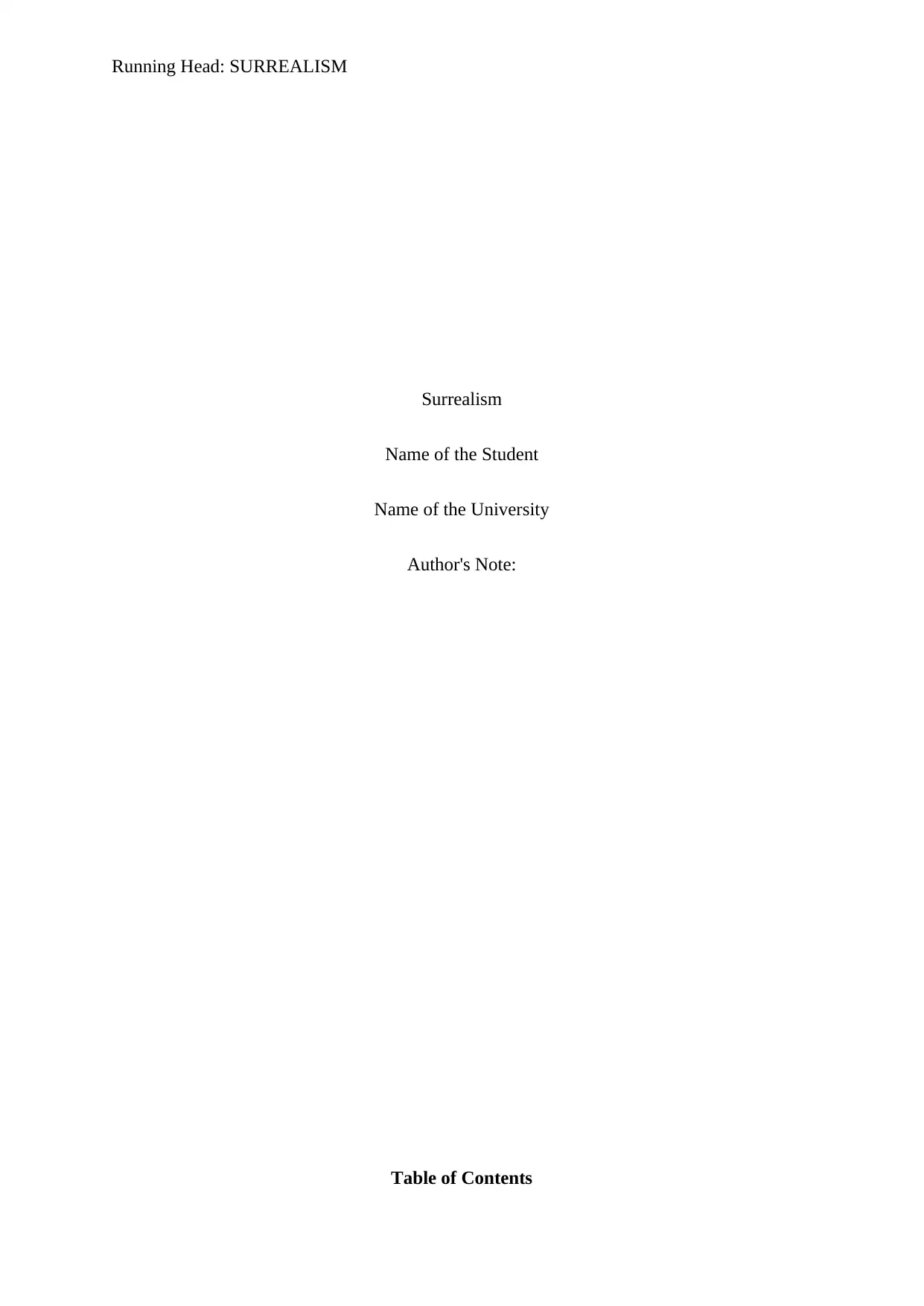
Running Head: SURREALISM
Surrealism
Name of the Student
Name of the University
Author's Note:
Table of Contents
Surrealism
Name of the Student
Name of the University
Author's Note:
Table of Contents
Paraphrase This Document
Need a fresh take? Get an instant paraphrase of this document with our AI Paraphraser

1SURREALISM
Introduction................................................................................................................................2
Pablo Picasso..............................................................................................................................2
Salvador Dali..............................................................................................................................3
Conclusion..................................................................................................................................5
References..................................................................................................................................6
Introduction................................................................................................................................2
Pablo Picasso..............................................................................................................................2
Salvador Dali..............................................................................................................................3
Conclusion..................................................................................................................................5
References..................................................................................................................................6
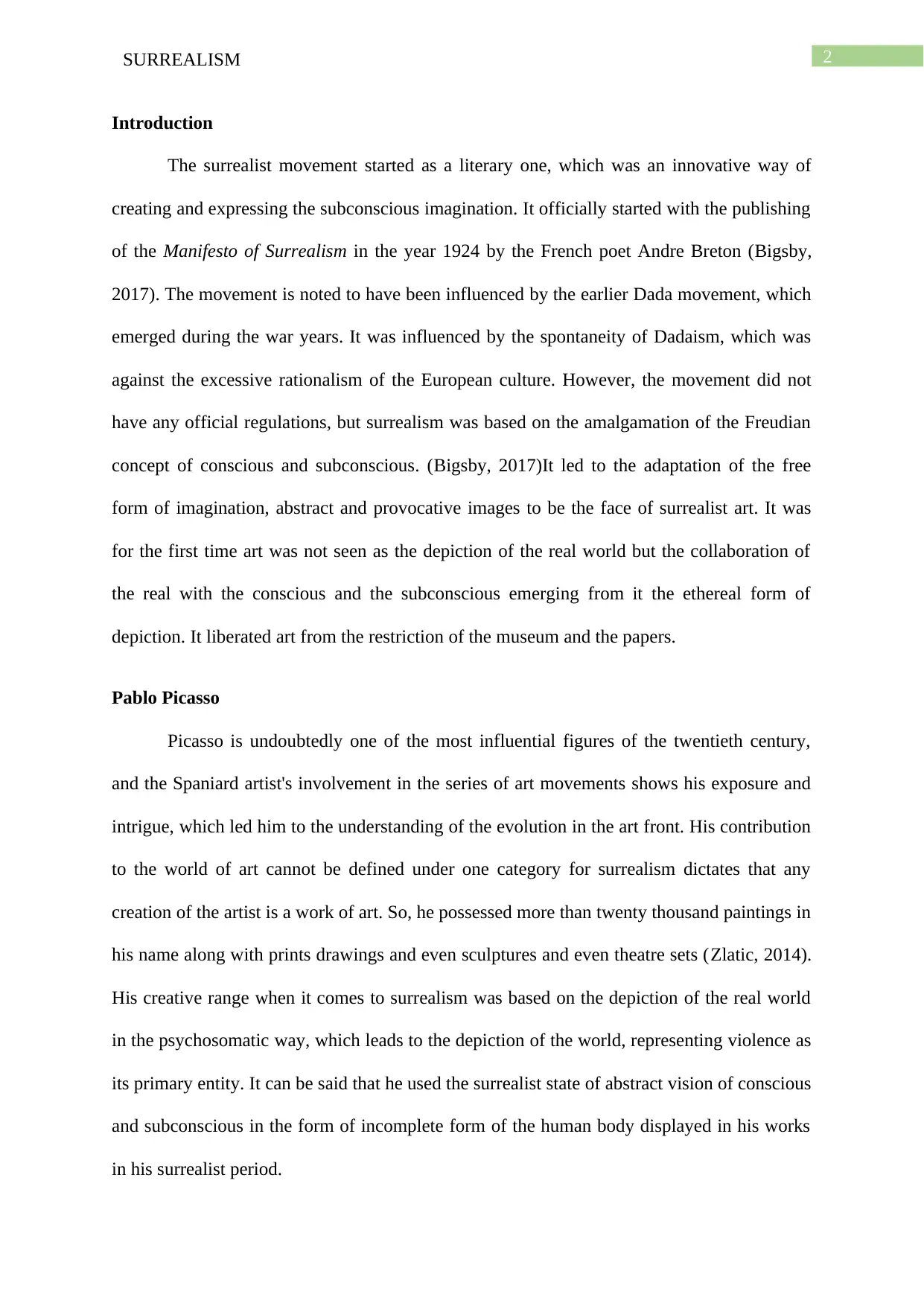
2SURREALISM
Introduction
The surrealist movement started as a literary one, which was an innovative way of
creating and expressing the subconscious imagination. It officially started with the publishing
of the Manifesto of Surrealism in the year 1924 by the French poet Andre Breton (Bigsby,
2017). The movement is noted to have been influenced by the earlier Dada movement, which
emerged during the war years. It was influenced by the spontaneity of Dadaism, which was
against the excessive rationalism of the European culture. However, the movement did not
have any official regulations, but surrealism was based on the amalgamation of the Freudian
concept of conscious and subconscious. (Bigsby, 2017)It led to the adaptation of the free
form of imagination, abstract and provocative images to be the face of surrealist art. It was
for the first time art was not seen as the depiction of the real world but the collaboration of
the real with the conscious and the subconscious emerging from it the ethereal form of
depiction. It liberated art from the restriction of the museum and the papers.
Pablo Picasso
Picasso is undoubtedly one of the most influential figures of the twentieth century,
and the Spaniard artist's involvement in the series of art movements shows his exposure and
intrigue, which led him to the understanding of the evolution in the art front. His contribution
to the world of art cannot be defined under one category for surrealism dictates that any
creation of the artist is a work of art. So, he possessed more than twenty thousand paintings in
his name along with prints drawings and even sculptures and even theatre sets (Zlatic, 2014).
His creative range when it comes to surrealism was based on the depiction of the real world
in the psychosomatic way, which leads to the depiction of the world, representing violence as
its primary entity. It can be said that he used the surrealist state of abstract vision of conscious
and subconscious in the form of incomplete form of the human body displayed in his works
in his surrealist period.
Introduction
The surrealist movement started as a literary one, which was an innovative way of
creating and expressing the subconscious imagination. It officially started with the publishing
of the Manifesto of Surrealism in the year 1924 by the French poet Andre Breton (Bigsby,
2017). The movement is noted to have been influenced by the earlier Dada movement, which
emerged during the war years. It was influenced by the spontaneity of Dadaism, which was
against the excessive rationalism of the European culture. However, the movement did not
have any official regulations, but surrealism was based on the amalgamation of the Freudian
concept of conscious and subconscious. (Bigsby, 2017)It led to the adaptation of the free
form of imagination, abstract and provocative images to be the face of surrealist art. It was
for the first time art was not seen as the depiction of the real world but the collaboration of
the real with the conscious and the subconscious emerging from it the ethereal form of
depiction. It liberated art from the restriction of the museum and the papers.
Pablo Picasso
Picasso is undoubtedly one of the most influential figures of the twentieth century,
and the Spaniard artist's involvement in the series of art movements shows his exposure and
intrigue, which led him to the understanding of the evolution in the art front. His contribution
to the world of art cannot be defined under one category for surrealism dictates that any
creation of the artist is a work of art. So, he possessed more than twenty thousand paintings in
his name along with prints drawings and even sculptures and even theatre sets (Zlatic, 2014).
His creative range when it comes to surrealism was based on the depiction of the real world
in the psychosomatic way, which leads to the depiction of the world, representing violence as
its primary entity. It can be said that he used the surrealist state of abstract vision of conscious
and subconscious in the form of incomplete form of the human body displayed in his works
in his surrealist period.
⊘ This is a preview!⊘
Do you want full access?
Subscribe today to unlock all pages.

Trusted by 1+ million students worldwide
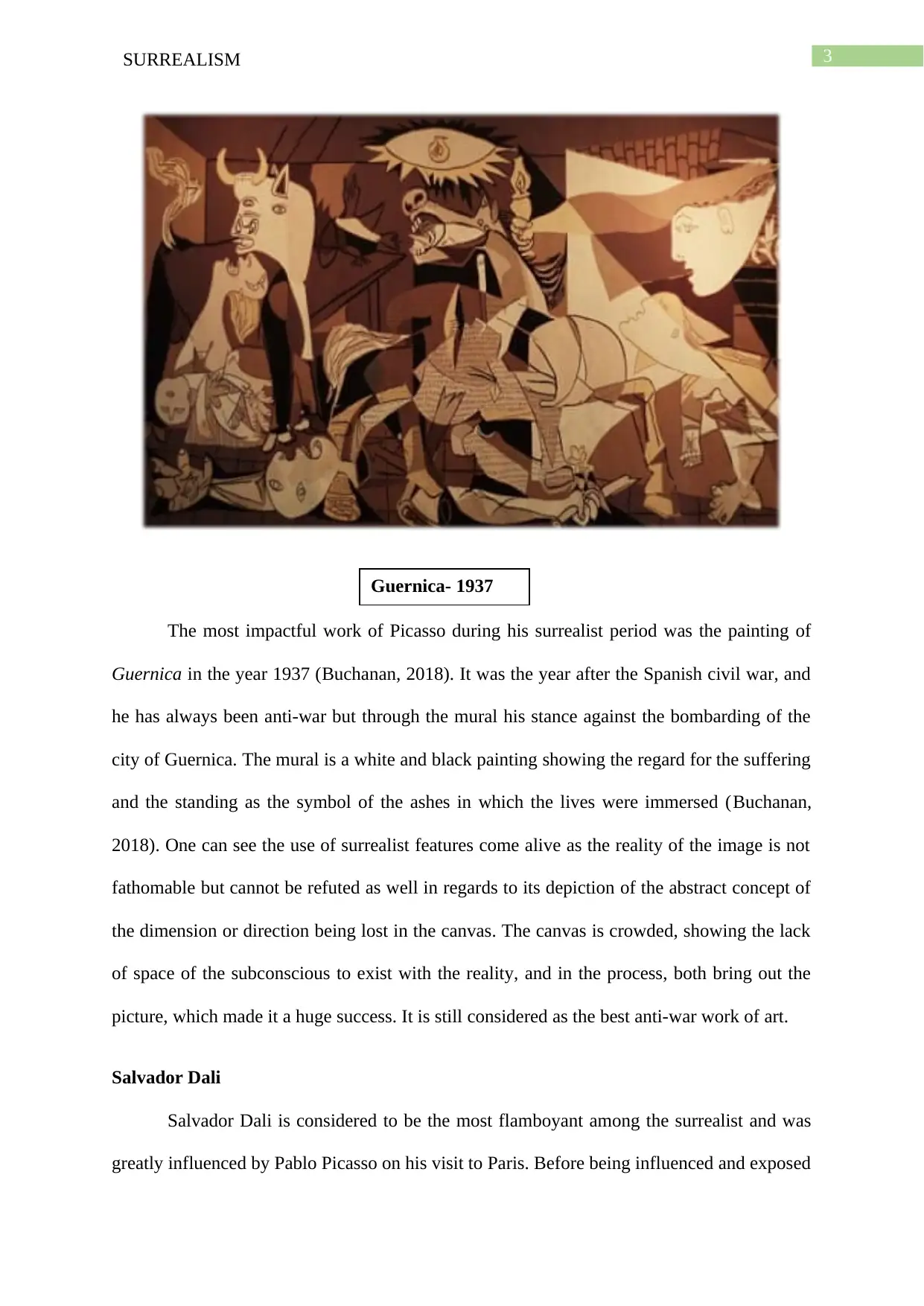
3SURREALISM
The most impactful work of Picasso during his surrealist period was the painting of
Guernica in the year 1937 (Buchanan, 2018). It was the year after the Spanish civil war, and
he has always been anti-war but through the mural his stance against the bombarding of the
city of Guernica. The mural is a white and black painting showing the regard for the suffering
and the standing as the symbol of the ashes in which the lives were immersed (Buchanan,
2018). One can see the use of surrealist features come alive as the reality of the image is not
fathomable but cannot be refuted as well in regards to its depiction of the abstract concept of
the dimension or direction being lost in the canvas. The canvas is crowded, showing the lack
of space of the subconscious to exist with the reality, and in the process, both bring out the
picture, which made it a huge success. It is still considered as the best anti-war work of art.
Salvador Dali
Salvador Dali is considered to be the most flamboyant among the surrealist and was
greatly influenced by Pablo Picasso on his visit to Paris. Before being influenced and exposed
Guernica- 1937
The most impactful work of Picasso during his surrealist period was the painting of
Guernica in the year 1937 (Buchanan, 2018). It was the year after the Spanish civil war, and
he has always been anti-war but through the mural his stance against the bombarding of the
city of Guernica. The mural is a white and black painting showing the regard for the suffering
and the standing as the symbol of the ashes in which the lives were immersed (Buchanan,
2018). One can see the use of surrealist features come alive as the reality of the image is not
fathomable but cannot be refuted as well in regards to its depiction of the abstract concept of
the dimension or direction being lost in the canvas. The canvas is crowded, showing the lack
of space of the subconscious to exist with the reality, and in the process, both bring out the
picture, which made it a huge success. It is still considered as the best anti-war work of art.
Salvador Dali
Salvador Dali is considered to be the most flamboyant among the surrealist and was
greatly influenced by Pablo Picasso on his visit to Paris. Before being influenced and exposed
Guernica- 1937
Paraphrase This Document
Need a fresh take? Get an instant paraphrase of this document with our AI Paraphraser
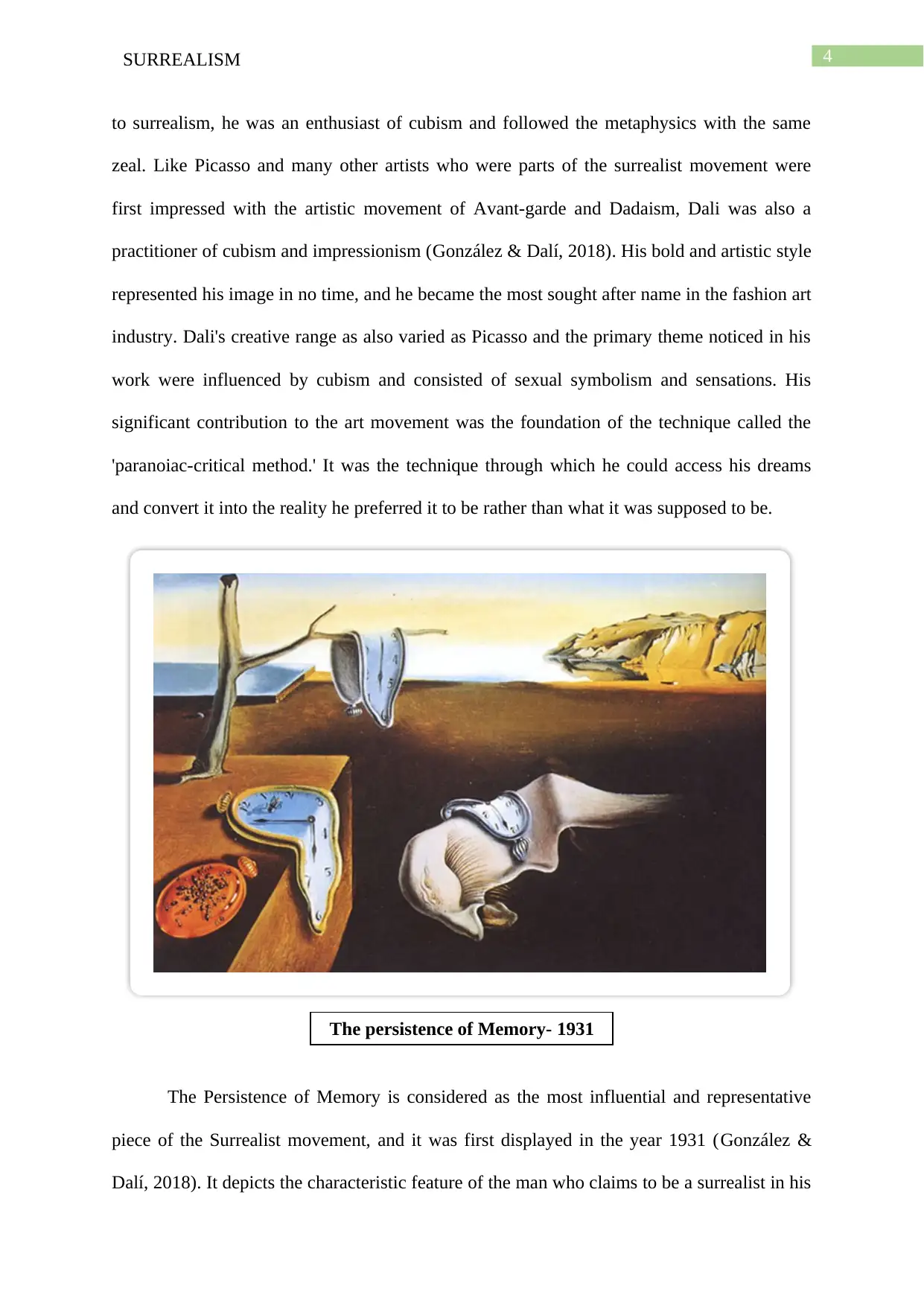
4SURREALISM
to surrealism, he was an enthusiast of cubism and followed the metaphysics with the same
zeal. Like Picasso and many other artists who were parts of the surrealist movement were
first impressed with the artistic movement of Avant-garde and Dadaism, Dali was also a
practitioner of cubism and impressionism (González & Dalí, 2018). His bold and artistic style
represented his image in no time, and he became the most sought after name in the fashion art
industry. Dali's creative range as also varied as Picasso and the primary theme noticed in his
work were influenced by cubism and consisted of sexual symbolism and sensations. His
significant contribution to the art movement was the foundation of the technique called the
'paranoiac-critical method.' It was the technique through which he could access his dreams
and convert it into the reality he preferred it to be rather than what it was supposed to be.
The Persistence of Memory is considered as the most influential and representative
piece of the Surrealist movement, and it was first displayed in the year 1931 (González &
Dalí, 2018). It depicts the characteristic feature of the man who claims to be a surrealist in his
The persistence of Memory- 1931
to surrealism, he was an enthusiast of cubism and followed the metaphysics with the same
zeal. Like Picasso and many other artists who were parts of the surrealist movement were
first impressed with the artistic movement of Avant-garde and Dadaism, Dali was also a
practitioner of cubism and impressionism (González & Dalí, 2018). His bold and artistic style
represented his image in no time, and he became the most sought after name in the fashion art
industry. Dali's creative range as also varied as Picasso and the primary theme noticed in his
work were influenced by cubism and consisted of sexual symbolism and sensations. His
significant contribution to the art movement was the foundation of the technique called the
'paranoiac-critical method.' It was the technique through which he could access his dreams
and convert it into the reality he preferred it to be rather than what it was supposed to be.
The Persistence of Memory is considered as the most influential and representative
piece of the Surrealist movement, and it was first displayed in the year 1931 (González &
Dalí, 2018). It depicts the characteristic feature of the man who claims to be a surrealist in his
The persistence of Memory- 1931
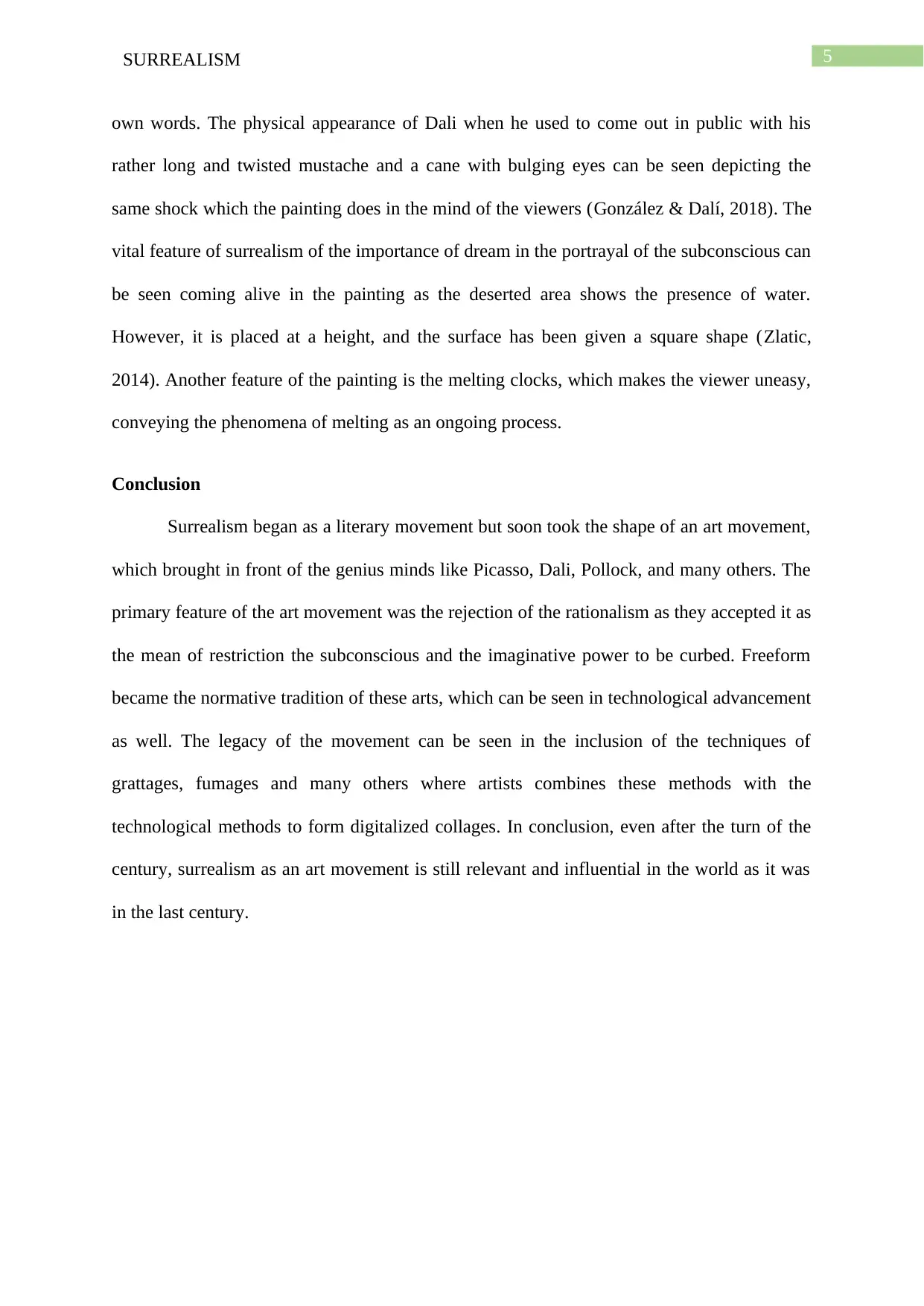
5SURREALISM
own words. The physical appearance of Dali when he used to come out in public with his
rather long and twisted mustache and a cane with bulging eyes can be seen depicting the
same shock which the painting does in the mind of the viewers (González & Dalí, 2018). The
vital feature of surrealism of the importance of dream in the portrayal of the subconscious can
be seen coming alive in the painting as the deserted area shows the presence of water.
However, it is placed at a height, and the surface has been given a square shape (Zlatic,
2014). Another feature of the painting is the melting clocks, which makes the viewer uneasy,
conveying the phenomena of melting as an ongoing process.
Conclusion
Surrealism began as a literary movement but soon took the shape of an art movement,
which brought in front of the genius minds like Picasso, Dali, Pollock, and many others. The
primary feature of the art movement was the rejection of the rationalism as they accepted it as
the mean of restriction the subconscious and the imaginative power to be curbed. Freeform
became the normative tradition of these arts, which can be seen in technological advancement
as well. The legacy of the movement can be seen in the inclusion of the techniques of
grattages, fumages and many others where artists combines these methods with the
technological methods to form digitalized collages. In conclusion, even after the turn of the
century, surrealism as an art movement is still relevant and influential in the world as it was
in the last century.
own words. The physical appearance of Dali when he used to come out in public with his
rather long and twisted mustache and a cane with bulging eyes can be seen depicting the
same shock which the painting does in the mind of the viewers (González & Dalí, 2018). The
vital feature of surrealism of the importance of dream in the portrayal of the subconscious can
be seen coming alive in the painting as the deserted area shows the presence of water.
However, it is placed at a height, and the surface has been given a square shape (Zlatic,
2014). Another feature of the painting is the melting clocks, which makes the viewer uneasy,
conveying the phenomena of melting as an ongoing process.
Conclusion
Surrealism began as a literary movement but soon took the shape of an art movement,
which brought in front of the genius minds like Picasso, Dali, Pollock, and many others. The
primary feature of the art movement was the rejection of the rationalism as they accepted it as
the mean of restriction the subconscious and the imaginative power to be curbed. Freeform
became the normative tradition of these arts, which can be seen in technological advancement
as well. The legacy of the movement can be seen in the inclusion of the techniques of
grattages, fumages and many others where artists combines these methods with the
technological methods to form digitalized collages. In conclusion, even after the turn of the
century, surrealism as an art movement is still relevant and influential in the world as it was
in the last century.
⊘ This is a preview!⊘
Do you want full access?
Subscribe today to unlock all pages.

Trusted by 1+ million students worldwide
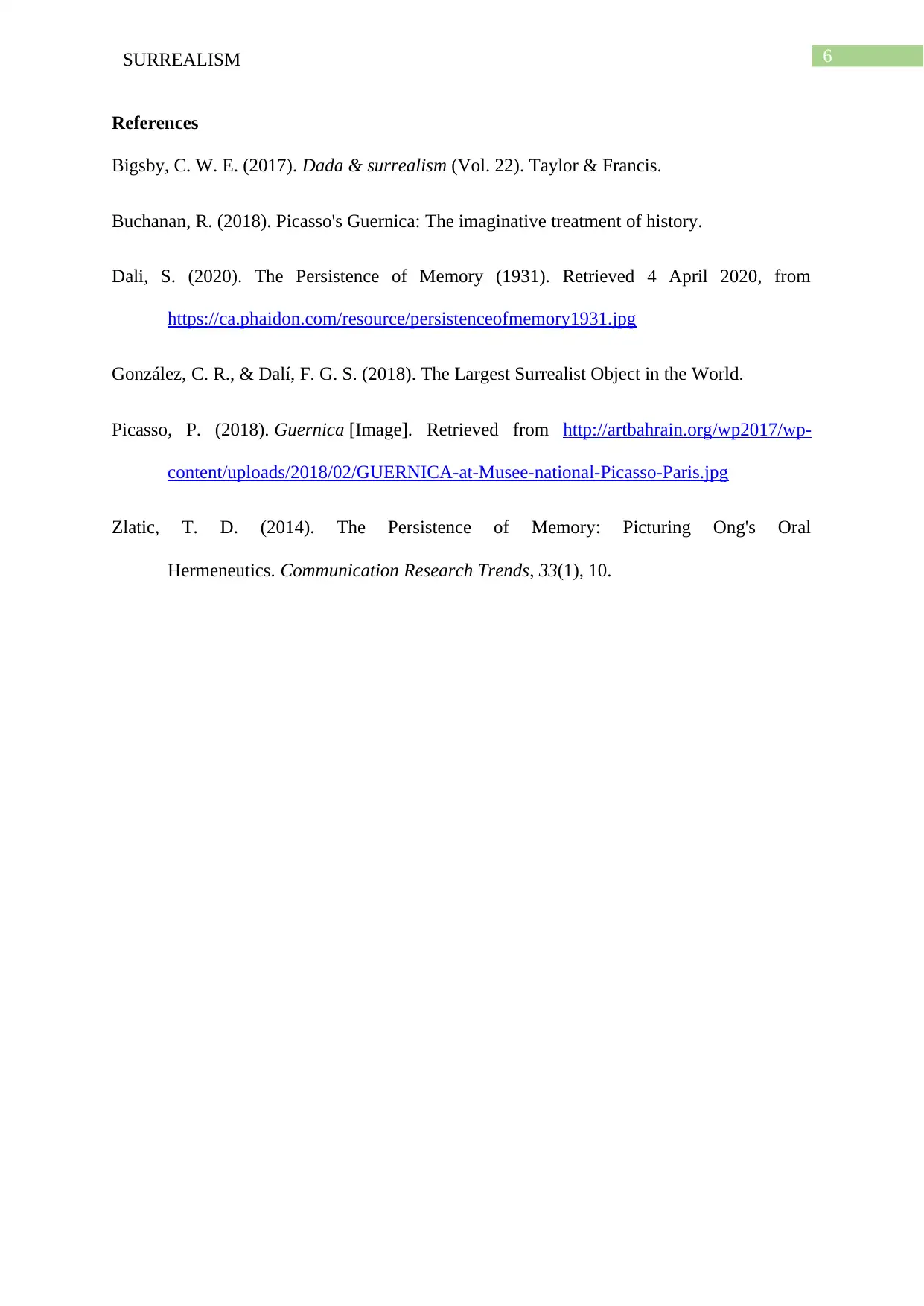
6SURREALISM
References
Bigsby, C. W. E. (2017). Dada & surrealism (Vol. 22). Taylor & Francis.
Buchanan, R. (2018). Picasso's Guernica: The imaginative treatment of history.
Dali, S. (2020). The Persistence of Memory (1931). Retrieved 4 April 2020, from
https://ca.phaidon.com/resource/persistenceofmemory1931.jpg
González, C. R., & Dalí, F. G. S. (2018). The Largest Surrealist Object in the World.
Picasso, P. (2018). Guernica [Image]. Retrieved from http://artbahrain.org/wp2017/wp-
content/uploads/2018/02/GUERNICA-at-Musee-national-Picasso-Paris.jpg
Zlatic, T. D. (2014). The Persistence of Memory: Picturing Ong's Oral
Hermeneutics. Communication Research Trends, 33(1), 10.
References
Bigsby, C. W. E. (2017). Dada & surrealism (Vol. 22). Taylor & Francis.
Buchanan, R. (2018). Picasso's Guernica: The imaginative treatment of history.
Dali, S. (2020). The Persistence of Memory (1931). Retrieved 4 April 2020, from
https://ca.phaidon.com/resource/persistenceofmemory1931.jpg
González, C. R., & Dalí, F. G. S. (2018). The Largest Surrealist Object in the World.
Picasso, P. (2018). Guernica [Image]. Retrieved from http://artbahrain.org/wp2017/wp-
content/uploads/2018/02/GUERNICA-at-Musee-national-Picasso-Paris.jpg
Zlatic, T. D. (2014). The Persistence of Memory: Picturing Ong's Oral
Hermeneutics. Communication Research Trends, 33(1), 10.
1 out of 7
Related Documents
Your All-in-One AI-Powered Toolkit for Academic Success.
+13062052269
info@desklib.com
Available 24*7 on WhatsApp / Email
![[object Object]](/_next/static/media/star-bottom.7253800d.svg)
Unlock your academic potential
Copyright © 2020–2025 A2Z Services. All Rights Reserved. Developed and managed by ZUCOL.





